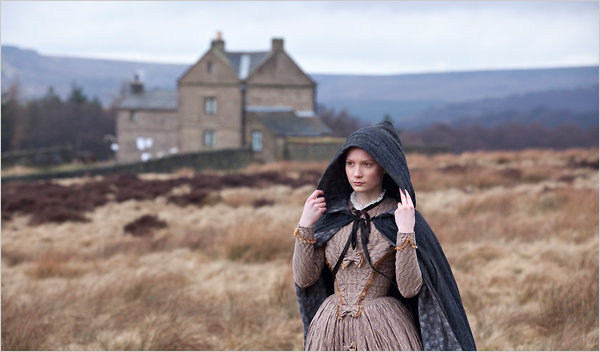Movie review by Greg Carlson
The oft-filmed “Jane Eyre,” which has been treated cinematically since at least 1910, tells a tale so compelling and romantic that very little time passes between productions. It has been only five years since Susanna White’s four-episode Masterpiece Theater edition, but filmmaker Cary Fukunaga, whose Mara Salvatrucha-focused feature debut “Sin Nombre” seems as far away from 19th century England as possible, crafts a handsome and engaging version of Charlotte Bronte’s famous novel that should please “Eyre” enthusiasts and newcomers alike. Although Fukunaga’s rendering of “Jane Eyre” will not be the last, it has already taken its place as one of the best.
Mia Wasikowska deftly interprets the title character through Jane’s considerable intelligence, desire for knowledge, and the “direct gaze” that accompanies Ms. Eyre’s candid observations and brutal honesty – and so transfixes her employer. Michael Fassbender’s charisma threatens to get in the way of some of Edward Fairfax Rochester’s brooding introspection, but the talented performer discovers the necessary balance between kindness and entitlement as well as genuine remorse and self-pity. Of course, both actors are gorgeous creatures far lovelier than the Jane and Rochester of the novel, and despite visual evidence to the contrary, one really believes Wasikowska when she unloads the speech containing the line, “Do you think that because I am poor, obscure, plain, and little that I am soulless and heartless?”
The range, scope, and scale of ideological concerns and genre territory carved out by Bronte provide interpreters with seemingly endless possibilities, allowing moviemakers the luxury of choosing any number of themes to explore with each new screen iteration of “Jane Eyre.” Eroticism and piety, fidelity and duplicity, and discrimination and equality are but a trio of ingenious contrasts addressed in the book’s pages. Fukunaga and screenwriter Moira Buffini alight decisively on Ms. Eyre’s sexual awakening without shortchanging core aspects of the novel’s social agenda. The filmmakers recognize Jane’s emerging concupiscence with subtlety and care, although one bold addition shows the artistically minded Jane regarding a framed nude with curiosity.
The most passionate fans of the novel will lament the loss of so many of Bronte’s exquisitely rendered scenes (imagine what Fassbender might have done with Rochester-disguised-as-gypsy), and the movie’s breathless stride demonstrates a certain ruthlessness on the part of Buffini. By reconfiguring the order of some key events via flashback, the movie briskly manages Jane’s transition from childhood at the miserable Lowood Institution to her appointment as governess at Thornfield Hall. With the exception of the heartbreaking fate of Helen Burns and a few other fleeting details, most of Jane’s boarding school trials have been truncated or excised altogether.
Additionally, Buffini smartly streamlines the entire post-Bertha Mason revelation episode, racing past much of St. John’s pushy and presumptuous pursuit of Jane’s hand and snipping out the revelation of Jane’s actual familial relationship to the Rivers family. By managing the events following Jane’s flight from Thornfield as a framing device, Fukunaga is able to place the film’s resolution much closer to the explosive climax of the story, a tactic in keeping with the film’s efficient pacing. The structural alterations, along with evocative sound and production design, Adriano Goldman’s sumptuous photography and Fukunaga’s commanding visual style, enthusiastically recommend this “Jane Eyre.”
